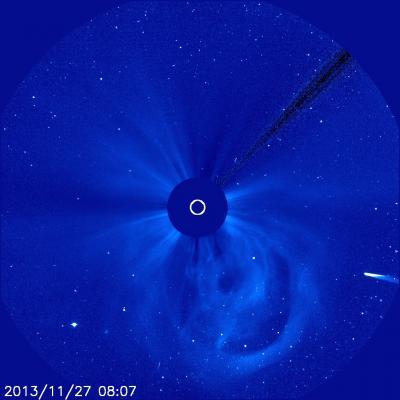C/2012 S1, Comet ISON, is intriguing because it has never approached the sun before and that is scientifically terrific.
Comet ISON began in the Oort cloud almost a light year away and has traveled for over a million years. Unlike more famous comets, Halley's as an example, it has never come this way before - and that means it is still made of pristine matter from the earliest days of the solar system's formation. Its top layers haven't been lost by a trip near the sun.
To study it as it approached Sol, a vast fleet of solar observation experiments have been watching. Would it break up or slingshot?
Observations over the weekend suggested ISON was getting dimmer and might already be in pieces but then yesterday the comet once again brightened. In the early hours of Nov. 27th, the comet appeared in the view of the European Space Agency/NASA mission SOHO - the Solar and Heliospheric Observatory in the Large Angle and Spectrometric Coronagraph instrument. Coronagraphs block out the bright light of the sun in order to better see the dimmer solar atmosphere, the corona.
In these images, the comet looks quite bright as it moves in from the lower right of the image. A giant cloud of solar material, called a coronal mass ejection or CME, is also seen in the images bursting off the bottom of the sun and heading out into space. It is as yet unclear if the CME is heading towards ISON but even if it does, it poses no real danger to the comet.

ISON enters the field of view of the joint ESA/NASA Solar and Heliospheric Observatory, or SOHO, spacecraft's C3 coronograph, where the brighter view of the sun itself is blocked to focus on the solar atmosphere, or corona. This video covers 17 hours beginning at 19:42 UT on Nov. 26, 2013. Credit: NASA SVS
If the comet has already broken up, it should disintegrate completely as it makes its slingshot around the sun. This would provide a great opportunity for scientists to see the insides of the comet, and better understand its composition — as such information holds clues about what material was present during the solar system's formation when this comet was born.
However, it would likely mean no comet visible in the night sky in December. We'll only know for sure after the comet rounds the sun later today.

Comet ISON streams toward the sun from the lower right in this image from the ESA/NASA Solar and Heliospheric Observatory mission, captured at 3:07 a.m. EST on Nov. 27, 2013. A cloud of solar material, called a coronal mass ejection, is seen under the sun. Credit: ESA/NASA/SOHO
The dates of viewings by these observatories are as follows:
Nov 21-28: STEREO-A Heliospheric Imager
Nov 26-29: STEREO-B coronagraphs
Nov 27-30: SOHO coronagraphs
Nov 28-29: STEREO-A coronagraphs
Nov 28: SDO
Nov 28: Hinode
And catch it all at NASA/Goddard Space Flight Center





Comments